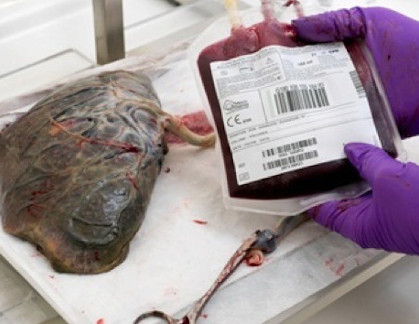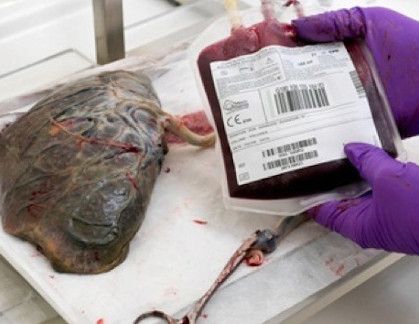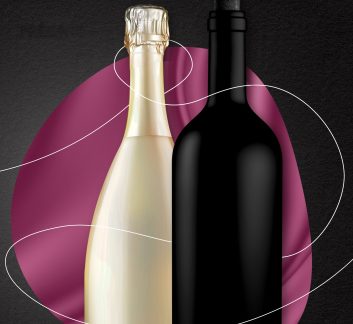Blood cancer: World premiere at Hôpital Maisonneuve-Rosemont
8 October 2020

Blood bag extracted from the umbilical cord, here with the placenta
Unresponsive to conventional treatment, a patient at Hôpital Maisonneuve-Rosemont (HMR) was saved thanks to a transplant improved by the addition of a molecule created in Montreal. Looking back to a miracle.
When the patient resists
The patient suffered from severe aplastic anemia. This disease destroys stem cells in the bone marrow and leads to a halt in the production of red blood cells, white blood cells and platelets.
It is most often an autoimmune disease, resulting from a defect in the immune system that causes it to attack normal bone marrow cells. The consequences are dramatic, including a high risk of hemorrhage and serious, life-threatening infections.
A world premiere at Hôpital Maisonneuve- Rosemont
Since the patient’s disease was resistant to standard treatments, it was decided to do a transplant using stem cells extracted from umbilical cord blood and expanded by the molecule UM171, discovered here in Montreal. This molecule allows umbilical cord stem cells to be multiplied (by a factor of more than 30) in the laboratory, making the transplant safer in adult patients.
This is a world first stemming from the discovery of a team of researchers from the Institute of Hemato-oncology and Cellular Therapy (iHOTC) of Hôpital Maisonneuve-Rosemont and the Institute for Research in Immunology and Cancer of the University of Montreal, whose research benefited greatly from the support of the HMR Foundation and its donors.
Transplantation: The challenge of finding a compatible donor
For this patient, the transplant team at Hôpital Maisonneuve-Rosemont, which included Dr. Jean Roy, hematologist and clinical researcher at Maisonneuve-Rosemont Hospital and full professor at the Université de Montréal’s Faculty of Medicine, aimed to perform an allograft (a transplant in which the donor is someone other than the patient himself).
Allografting makes it possible to cure severe aplastic anemia. Nevertheless, in these cases, when considering an allogeneic transplant, the donor’s stem cells must be as compatible as possible with those of the recipient to avoid the risk of immunological complications. A donor is first sought in the family (siblings) or in unrelated donor registries.
In the absence of a family or unrelated donor, stem cells from a semi-identical (i.e., partially matched) family donor, also known as a “haplo-identical donor”, may be considered under certain conditions. However, this family member must be healthy and available for such a procedure. Unfortunately, this was not the case for this young patient.
Cord blood transplant: advantages and disadvantages
Cord blood transplant: advantages
Cord blood transplantation:
- Is less demanding in terms of compatibility;
- Is an option for many patients who need a stem cell transplant but cannot find a donor in their family or in donor registries. This is particularly true for non-Caucasian patients.
- Seems to decrease the risk of relapse in patients with hematological cancers.
- Is associated with a lower incidence of long-term immunologic complications.
Disadvantages of cord blood transplantation
Cord blood, on the other hand, generally does not contain enough stem cells for an adult patient weighing more than 70 kg. This results in slow recovery of the blood cells with a higher risk of infection and death.
In addition, the rate of graft rejection, i.e. the destruction of the injected cord cells at the time of transplantation by the recipient’s immune system, is very high in patients with severe aplastic anemia who have received multiple blood transfusions.
Suddenly, the molecule UM171
While amplified cells had never been used to treat this type of anemia, the researchers of Dr. Roy’s team were right: They succeeded in curing the first adult patient with severe aplastic anemia thanks to an umbilical cord blood transplant expanded with the UM171 molecule.
Stem cell therapy: Reprogramming patient histories
The Maisonneuve-Rosemont Hospital Foundation is proud to have funded, thanks to its donors, the research of Dr. Jean Roy and his team in connection with the UM171 molecule.
Their work demonstrates the importance and power of cell therapy and stem cell treatments, which represent the future of medicine, but are already saving lives today. Without this novel treatment, our young patient would not be alive today. Thanks to the incredible power and commitment of our donors, we were able to reprogram his story!
˃ Read UM171 saves another life, Health Medicine Journal
˃ Read UM171 molecule saves life of young man suffering from severe aplastic anemia, News Medical Life Science, September 30th, 2020









